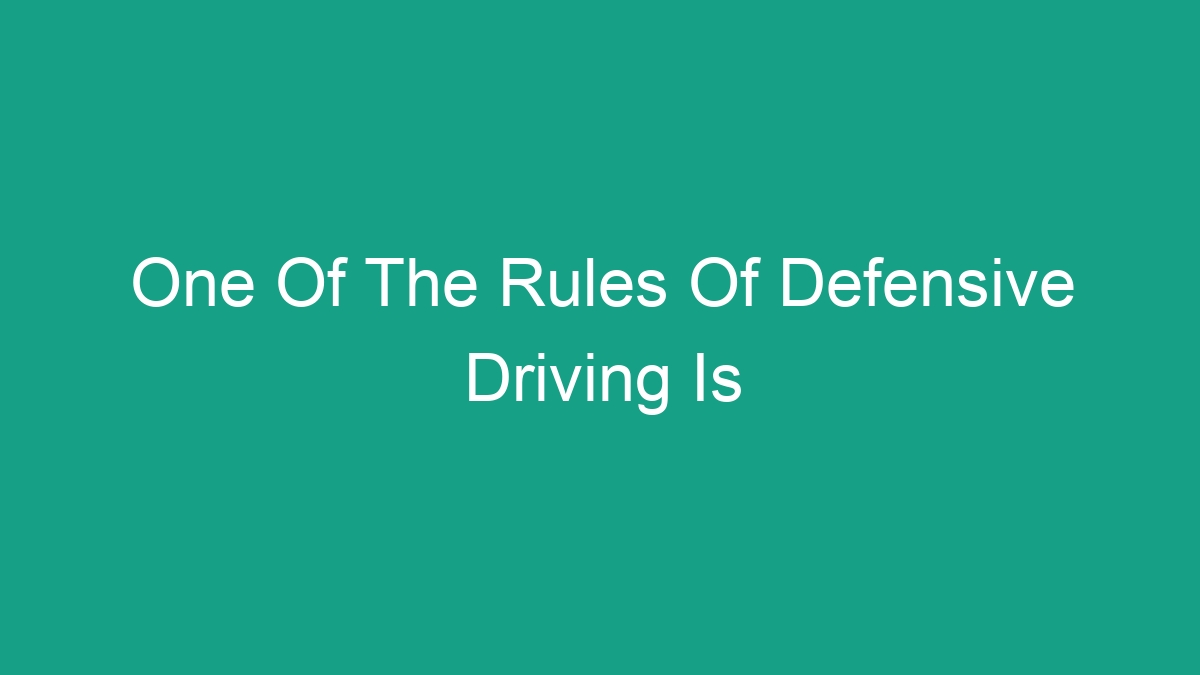
Defensive driving is a crucial skill that every driver should possess. It not only ensures your safety but also the safety of others on the road. By following the rules of defensive driving, you can reduce the risk of accidents and maintain a safe driving environment. One of the rules of defensive driving is to always be aware of your surroundings and potential hazards. In this article, we will explore this rule in depth and discuss other important rules of defensive driving.
Be Aware of Your Surroundings
Being aware of your surroundings is one of the fundamental rules of defensive driving. This means constantly scanning the road ahead, checking your mirrors, and being mindful of other vehicles around you. By staying alert and aware, you can anticipate potential hazards and react quickly to prevent accidents. Here are some key points to keep in mind when it comes to being aware of your surroundings:
- Scan the road ahead: Look ahead and identify any potential hazards such as slow-moving vehicles, pedestrians, or road obstacles.
- Check your mirrors: Regularly check your rearview and side mirrors to be aware of vehicles approaching from behind or driving alongside you.
- Use your turn signals: Signaling your intentions helps other drivers anticipate your actions, reducing the risk of collisions.
By following these simple practices, you can significantly improve your ability to react to unexpected situations on the road, making you a safer and more responsible driver.
Maintain a Safe Following Distance
Maintaining a safe following distance is another important rule of defensive driving. Keeping a safe distance from the vehicle in front of you gives you more time to react if they suddenly brake or slow down. This can help prevent rear-end collisions and minimize the risk of being involved in a chain-reaction accident. Here are some guidelines for maintaining a safe following distance:
- Follow the 3-second rule: Choose a stationary object on the side of the road and count how many seconds it takes for the car in front of you to pass it. You should allow at least 3 seconds of following distance in normal driving conditions.
- Adjust for adverse conditions: Increase your following distance in poor weather conditions, heavy traffic, or at night when visibility is reduced.
By adhering to these guidelines, you can reduce the likelihood of rear-end collisions and make the road a safer place for everyone.
Anticipate the Actions of Other Drivers
Anticipating the actions of other drivers is a key aspect of defensive driving. By being proactive and predicting the behavior of other road users, you can better prepare yourself to react to potential hazards. Here are some tips for anticipating the actions of other drivers:
- Watch for signs of aggression or impatience: If a driver is tailgating, weaving in and out of traffic, or displaying other aggressive behaviors, it’s important to give them extra space and be prepared for sudden maneuvers.
- Be cautious at intersections: Many accidents occur at intersections due to drivers running red lights or making sudden turns. Approach intersections with caution and be prepared to yield or stop if necessary.
- Expect the unexpected: Always be prepared for the unexpected actions of other drivers, such as sudden lane changes, illegal U-turns, or abrupt stops.
By honing your ability to anticipate the actions of other drivers, you can navigate the road with greater confidence and avoid potential collisions.
Obey Traffic Laws and Signs
Obeying traffic laws and signs is a fundamental rule of defensive driving. Adhering to speed limits, traffic signals, and road signs is essential for maintaining order and safety on the road. Here are some important aspects of obeying traffic laws and signs:
- Respect speed limits: Speed limits are set to ensure the safety of all road users. Exceeding the speed limit not only puts you at risk but also endangers others.
- Follow traffic signals: Stop at red lights, yield at intersections, and obey traffic signals to prevent accidents and maintain the flow of traffic.
- Be mindful of road signs: Pay attention to signs indicating curves, intersections, pedestrian crossings, and other important information that can affect your driving.
By following these rules and regulations, you can contribute to a safer and more organized driving environment for everyone.
Avoid Distractions
Avoiding distractions is a critical rule of defensive driving. Distracted driving, such as using a cellphone, eating, adjusting the radio, or engaging in conversations, can significantly impair your ability to focus on the road. Here are some measures to eliminate distractions while driving:
- Put away electronic devices: Keep your cellphone out of reach and avoid using it while driving. If you need to make a call or send a text, pull over to a safe location.
- Focus on the road: Keep your attention on the task of driving and avoid getting lost in thought, daydreaming, or becoming preoccupied with non-driving-related activities.
- Minimize external distractions: If passengers or loud music are distracting you, try to reduce the disturbance or ask for cooperation from those around you.
By staying focused and attentive, you can react more effectively to potential dangers and help prevent accidents caused by distractions.
Conclusion
Defensive driving is an essential skill for all drivers, and adhering to its rules is the key to creating a safer road environment. By being aware of your surroundings, maintaining a safe following distance, anticipating the actions of other drivers, obeying traffic laws and signs, and avoiding distractions, you can significantly reduce the risk of accidents and contribute to a more harmonious driving experience for everyone.
By understanding and implementing the rules of defensive driving, we can work together to make the roads safer and ensure the well-being of all road users.




